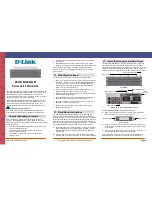
659
Configuring IPv6 Host Functions
Information About Configuring IPv6 Host Functions
Link local unicast addresses can be automatically configured on any interface by using the link-local prefix
FE80::/10(1111 1110 10) and the interface identifier in the modified EUI format. Link-local addresses are used in the
neighbor discovery protocol (NDP) and the stateless autoconfiguration process. Nodes on a local link use link-local
addresses and do not require globally unique addresses to communicate. IPv6 routers do not forward packets with
link-local source or destination addresses to other links.
For more information, see the section about IPv6 unicast addresses in the “Implementing IPv6 Addressing and Basic
Connectivity” chapter in the
Cisco IOS IPv6 Configuration Library
on Cisco.com.
DNS for IPv6
IPv6 supports Domain Name System (DNS) record types in the DNS name-to-address and address-to-name lookup
processes. The DNS AAAA resource record types support IPv6 addresses and are equivalent to an A address record in
IPv4. The switch supports DNS resolution for IPv4 and IPv6.
ICMPv6
The Internet Control Message Protocol (ICMP) in IPv6 generates error messages, such as ICMP destination unreachable
messages, to report errors during processing and other diagnostic functions. In IPv6, ICMP packets are also used in the
neighbor discovery protocol and path MTU discovery.
Neighbor Discovery
The switch supports NDP for IPv6, a protocol running on top of ICMPv6, and static neighbor entries for IPv6 stations that
do not support NDP. The IPv6 neighbor discovery process uses ICMP messages and solicited-node multicast addresses
to determine the link-layer address of a neighbor on the same network (local link), to verify the reachability of the
neighbor, and to keep track of neighboring routers.
The switch supports ICMPv6 redirect for routes with mask lengths less than 64 bits. ICMP redirect is not supported for
host routes or for summarized routes with mask lengths greater than 64 bits.
Neighbor discovery throttling ensures that the switch CPU is not unnecessarily burdened while it is in the process of
obtaining the next hop forwarding information to route an IPv6 packet. The switch drops any additional IPv6 packets
whose next hop is the same neighbor that the switch is actively trying to resolve. This drop avoids further load on the
CPU.
Default Router Preference
The switch supports IPv6 default router preference (DRP), an extension in router advertisement messages. DRP improves
the ability of a host to select an appropriate router, especially when the host is multihomed and the routers are on different
links. The switch does not support the Route Information Option in RFC 4191.
An IPv6 host maintains a default router list from which it selects a router for traffic to offlink destinations. The selected
router for a destination is then cached in the destination cache. NDP for IPv6 specifies that routers that are reachable or
probably reachable are preferred over routers whose reachability is unknown or suspect. For reachable or probably
reachable routers, NDP can either select the same router every time or cycle through the router list. By using DRP, you
can configure an IPv6 host to prefer one router over another, provided both are reachable or probably reachable.
For more information about DRP for IPv6, see the “Implementing IPv6 Addresses and Basic Connectivity” chapter in the
Cisco IOS IPv6 Configuration Library
on Cisco.com.
IPv6 Stateless Autoconfiguration and Duplicate Address Detection
The switch uses stateless autoconfiguration to manage link, subnet, and site addressing changes, such as management
of host and mobile IP addresses. A host autonomously configures its own link-local address, and booting nodes send
router solicitations to request router advertisements for configuring interfaces.
Summary of Contents for IE 4000
Page 12: ...8 Configuration Overview Default Settings After Initial Switch Configuration ...
Page 52: ...48 Configuring Interfaces Monitoring and Maintaining the Interfaces ...
Page 108: ...104 Configuring Switch Clusters Additional References ...
Page 128: ...124 Performing Switch Administration Additional References ...
Page 130: ...126 Configuring PTP ...
Page 140: ...136 Configuring CIP Additional References ...
Page 146: ...142 Configuring SDM Templates Configuration Examples for Configuring SDM Templates ...
Page 192: ...188 Configuring Switch Based Authentication Additional References ...
Page 244: ...240 Configuring IEEE 802 1x Port Based Authentication Additional References ...
Page 298: ...294 Configuring VLANs Additional References ...
Page 336: ...332 Configuring STP Additional References ...
Page 408: ...404 Configuring DHCP Additional References ...
Page 450: ...446 Configuring IGMP Snooping and MVR Additional References ...
Page 490: ...486 Configuring SPAN and RSPAN Additional References ...
Page 502: ...498 Configuring Layer 2 NAT ...
Page 770: ...766 Configuring IPv6 MLD Snooping Related Documents ...
Page 930: ...926 Configuring IP Unicast Routing Related Documents ...
Page 976: ...972 Configuring Cisco IOS IP SLAs Operations Additional References ...
Page 978: ...974 Dying Gasp ...
Page 990: ...986 Configuring Enhanced Object Tracking Monitoring Enhanced Object Tracking ...
Page 994: ...990 Configuring MODBUS TCP Displaying MODBUS TCP Information ...
Page 996: ...992 Ethernet CFM ...
Page 1066: ...1062 Using an SD Card SD Card Alarms ...
















































